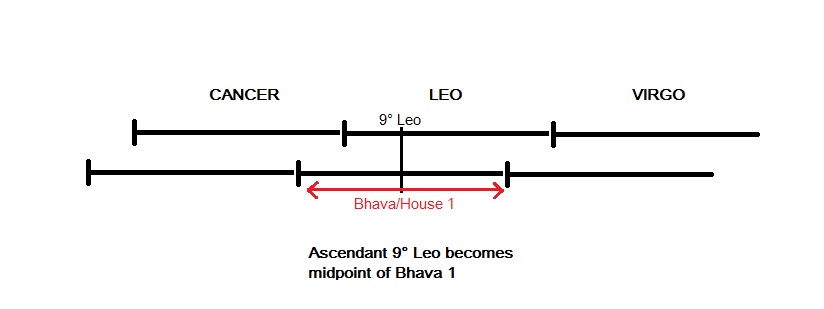The Bhava Chalit chart is a chart that is used to find the position of the planets in the houses relative to the actual Lagna degree. This chart is vital in the determination of which house each planet actually falls into.
Rashi Chart
Anyone who is familiar with the basics of astrology knows that the Rashis are the divisions of the 360 degrees of the Zodiac into twelve sections of 30 degrees each. These Rashis are labelled Mesha (Aries), Rishaba (Taurus), Mithuna (Gemini), Kark (Cancer), Simha (Leo), Kanya (Virgo), Tula (Libra), Vrishik (Scorpio), Dhanus (Saggitarius), Makara (Capricorn), Kumbha (Aquarius) and Meena (Pisces). These Rashis are the basic foundation of any birth chart.
Each Rashi is owned by a Graha. When we interpret a chart we look at the Rashi that the planet is placed in. The lordship of the Rashi and the placement of that Graha is of great importance.
Lagna
The Lagna or ascendant is the key to the birth chart. This is because the Lagna is the place from which the houses of the chart are counted. For example, in a Rashi chart, if the Lagna is in Rishaba (Taurus), Mithuna (Gemini) is the second house, Kark (Cancer) is the third house and so on. This is based on the assumption that the first house begins at the degree that the Rashi that the Lagna Rashi begins at.
Bhava Chalit / Bhav Chalit
Bhav means house and Chalit means mobile or movement. So the Bhava Chalit chart moves the houses. This movement of the house table happens when we draw the Bhava Chalit chart relative to the actual Lagna degree and not the Rashi degrees.
When the Lagna degree is at the midpoint of the Rashi itself, around 15 degrees, the Rashi chart and the Bhav Chalit chart will be exactly the same. The Bhava Chalit Chart makes a big difference for charts where the Lagna degree is away from the midpoint of the Rashi.
Calculating The Bhava Chalit Chart
As with most Vedic astrology concepts there is more than one way of calculating the same thing. The Bhava Chalit chart is no exception. In the Equal House Method, there are two schools of thought as to how this chart should be calculated.
- Using the Lagna degree as the Bhav Madhya or middle of the house
- Using the Lagna degree as the start point of the house
The first method is the more popular one. In this method, the Lagna degree is taken as the middle of the Bhav or house. Since each house is of a 30-degree span we make the Lagna degree the middle of the house and then redraw the houses with the start of the house 15 degrees before the Lagna degree and the end of the house 15 degrees after the Lagna degree. When we do this we will see that some planets may move to the next or the previous house.
Another method called the unequal house method uses the latitude and longitude of the birth location to calculate the degree span of each house. This is a method that has found much favour with certain astrologers. However, in a latitude that is much further away from the equator, the houses get very skewed.
To better understand how the Lagna degree can actually change the Bhava Chart let us look at two examples. In our examples, the planetary degrees are the same. But, in one example we shall calculate the Bhava Chart with the Lagna at 9 degrees and in the other with the Lagna at 23 degrees.
- Sun 1° Gemini
- Moon 21° Pisces
- Mars 28° Aquarius
- Mercury 20° Gemini
- Jupiter 1° Capricorn
- Venus 13° Taurus
- Saturn 6° Capricorn
- Rahu 5° Gemini
- Ketu 5° Saggitarius
Example 1: Ascendant at 9° Leo
Here we see that the as per the Rashi Chart the placement of the Planets is as follows:
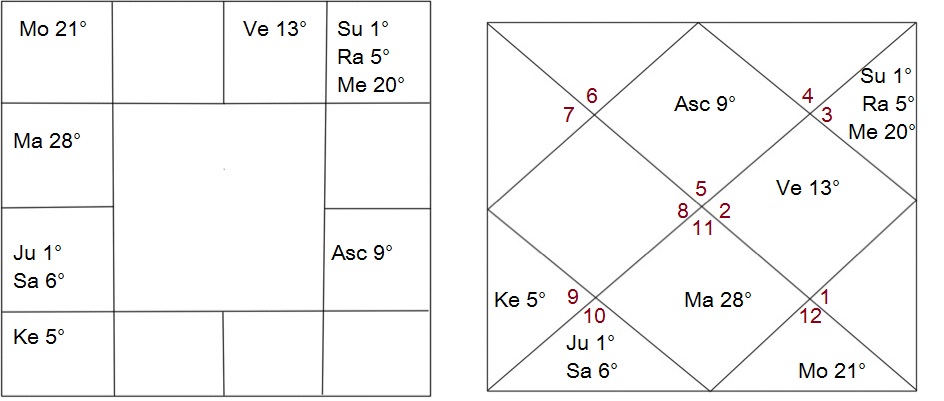
But if we use the 9° Leo as the midpoint or Bhav Madhya for the first Bhava we can find the Bhava start and end as follows.
Bhava 1 begins at 9° Leo – 15°= -6°. This negative value means the start of the first Bhava will go 6° back into the previous Rashi. So the calculation is (30°-6°) = 24° Cancer.
Bhava 1 will end at 9° Leo + 15°= 24° Leo.
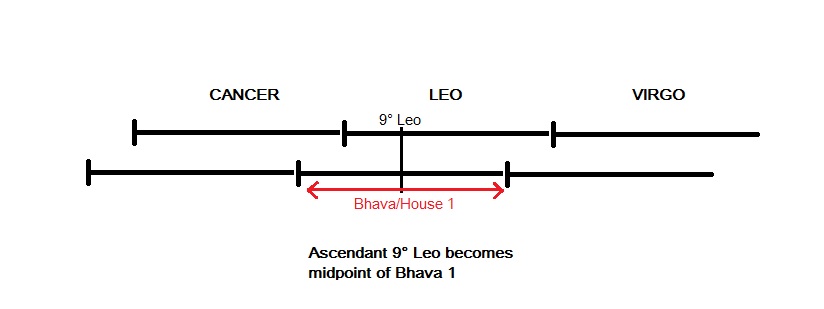
How The Midpoint Shifts The Bhava Start And End
Similarly, all the Bhavas will start and end at the same point.
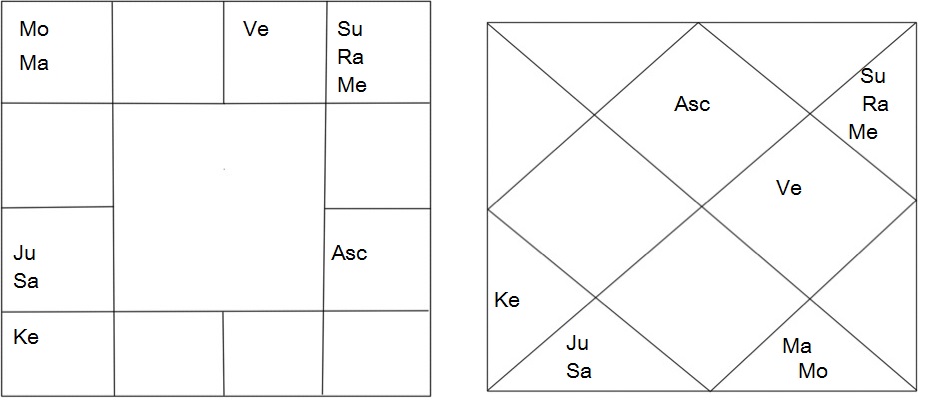
When we redraw the borders for the Bhava Chart, the planets that are in degrees higher than 24° will go to the next Bhava or house. In our example, Mars is the only planet with a degree higher than 24°. It is at 28° Aquarius which is the 7th Rashi from the Lagna and in the Bhava Chart, it joins Moon in the 8th Bhava.
Example 2: Ascendant at 23° Leo
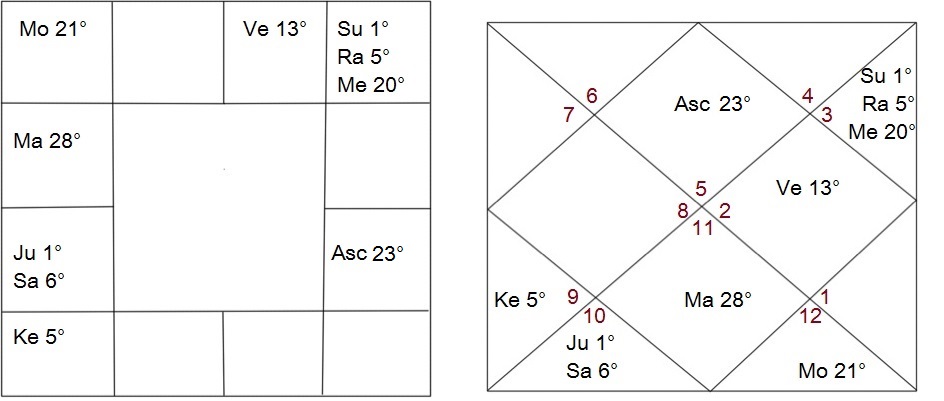
Rashi Chart Ascendant/Lagna at 23 Degrees Leo
But if we use the 23° Leo as the midpoint for the first Bhava we can find the Bhava start and end as follows.
Bhava 1 begins at 23° Leo – 15°= 8° Leo.
Bhava 1 will end at 23° Leo + 15°= 38°. Since the value is greater than 30° it means that the Bhava 1 will end in the next Rashi. So the calculation is (38°-30°) = 8° Virgo.
All, the Bhavas or houses will shift in a similar manner.
The planets that are of a degree earlier than 8° will all move to the previous Bhava in the Bhava Chalit chart, namely; Sun 1° Gemini, Jupiter 1° Capricorn, Saturn 6° Capricorn, Rahu 5° Gemini and also Ketu 5° Saggitarius.
So, when we draw the Bhava Chalit chart it will look as follows:
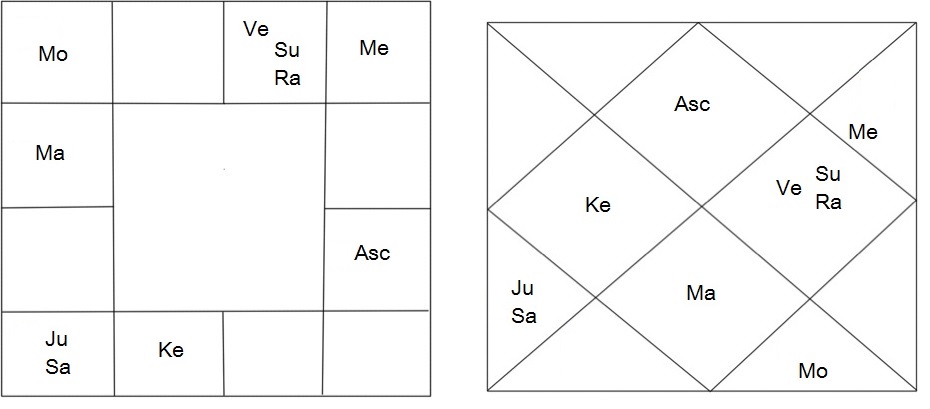
Most astrology software calculates this chart. It is always good to know how to manually calculate it in case software is not available to do so. Practice will make the process easy enough that just looking at the Rashi chart and degrees will be enough to mentally place the planets properly in the Bhava Chalit chart.
One point to note is that when multiple planets move houses, they will all move in the same direction. So if you find that when manually calculating the Bhava Chalit chart, one planet moves backwards and another forward, there is something wrong with your calculations.
Alternate Method Of Bhava Chart Calculation
The majority of astrologers follow the method described above making the ascendant degree the midpoint of the Bhavas. However, there is also another school of thought. Some astrologers use the Lagna degree itself as the start of the first Bhava. Most astrology software will allow you to tweak the settings to calculate the Bhava chart using the method that you prefer.
How Do We Use The Bhava Chart?
The Bhava Chart is to be used when the house in which a planet is placed is studied. Many a time astrologers see favourable placements in the Rashi chart and predict great things. However, when you study the Bhava Chalit chart the planet may have moved to another house or Bhava. This would alter or nullify the interpretation of the placement. Many charts have beautiful or not so favourable Yogas. But, these placements do not show any results in the actual life of the person. While this is often used as a good excuse to debunk the rules of astrology, they might actually be incorrect assessments. Reading a chart without studying the Yogas in-depth in the Navamsa as well as the Bhava Chalit chart could in some cases lead to misinterpretation.
So, when interpreting a placement which is wholly dependent on the house placement of a planet, the Bhava Chalit chart is the most accurate one to use. For example, a person might have Mars in the 4th house as per the Rashi chart. But, in the Bhava Chalit chart, the planet Mars may have moved back to the 3rd house or moved forward to the 5th house. This may totally change the interpretation of the chart with regard to Mangal Dosh.
It is also important to use the Bhava chart to see where the lord of each house is placed. One must use the Rashi chart to see the lordship of each house. We then use the Bhava Chalit chart to see where these lords are placed.
How Not To Use The Bhava Chalit Chart
One must always keep in mind that the Bhava Chalit chart, as the name indicates is only to see the Bhava or house placement of the planet. One cannot emphasize enough that the Rashi in which a planet is placed is always seen from the Rashi chart only.
Aspects are also to be seen from the Rashi chart. For beginners, the Rashi chart is a good place to study aspects. As the knowledge of Vedic astrology grows, the exact degrees of the planets can be used to see where exactly the strongest aspects fall.
Conclusion
So, though the overall chart of a person is presented as the Rashi chart, an astrologer is better advised to use the Navamsa as well as the Bhava Chalit chart to get a detailed picture of the chart. The Navamsa will give details about the actual strength of the planet. The Bhava Chalit gives a detailed picture of the actual placement of the planet.




